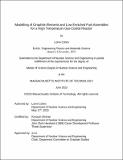Modelling of Graphite Elements and Low Enriched Fuel Assemblies for a High Temperature Gas-Cooled Reactor
Author(s)
Cohen, Lorne
DownloadThesis PDF (5.449Mb)
Advisor
Shirvan, Koroush
Terms of use
Metadata
Show full item recordAbstract
As the consequences of climate change continue to have worldwide impacts, innovations in nuclear energy are a necessity for decarbonizing electricity and process heat generation. To address the large capital costs and risk of large Pressurized Water Reactors (PWRs), Stewart et al. designed a Horizontal Compact High Temperature Gas-cooled Reactor (HC-HTGR), which Boston Atomics is seeking to commercialize. The HC-HTGR leverages the safety advantages of gas- cooled, TRISO fuelled reactors, and the economic advantages of a horizontal compact layout. Graphite assembly blocks create the channels that guide the helium coolant flow and contain the fuel compacts in the HC-HTGR. Given the low tensile strength of graphite, FEA analysis is required for predicting stresses within these components. The stresses are evaluated using the ASME code for graphite components in nuclear reactors. A 2D generalized plane strain model is used to predict the ASME equivalent stresses throughout assemblies at the inlet, midplane, and outlet over 15 years of steady state operation. The effects of creep, swelling, and thermal expansion are incorporated into the model. The results predict the maximum equivalent stress will not exceed the limit of 12 MPa from the ASME code. Large thermal stresses are induced due to the high midplane and outlet temperatures but are quickly reduced by irradiation effects. As expected, creep plays a significant role in reducing the stresses that are driven by irradiation shrinkage of the graphite block.
The use of TRISO fuel in an HC-HTGR provides safety benefits but adds significant fuel costs due to the manufacturing and fuel enrichment price. To improve the economics of the reactor, multiple designs for low-enriched fuel assemblies are evaluated on a thermal-hydraulic, neutronic, and economic basis. The designs use a combination of UC and UO₂ fuel, with SiC composite and stainless-steel cladding. While each design meets the target reactivity, enrichment, and temperature limits, the most viable design for near-term deployment uses UO₂ fuel with 0.5 mm of stainless-steel cladding. This design has an enrichment of 4.249% and maximum fuel temperature of 1414°C, under the assumed conservative steady-state conditions. A preliminary analysis indicates a 38-60% reduction in fuel costs compared to the TRISO fuelled assembly for the same energy output. The wide use of UO₂ and stainless steel in the nuclear industry supports the near-term deployment of this assembly design, as both materials are licensed for use in nuclear reactors, unlike SiC composite cladding and UC fuel. This precedent also reduces uncertainties on the fuel cost since there are well established supply chains for both UO₂ and nuclear grade stainless steel.
Additionally, in order to improve the performance of stainless-steel cladding, oxide dispersion strengthened (ODS) steel cladding samples fabricated with high velocity oxy-fuel deposition were investigated. The XRD and XRF analyses led to the conclusion that rapid cooling after deposition results in an amorphous microstructure with a crystalline chromium phase. The bulk material is brittle, as confirmed by ring compression tests, motivating improvement in the fabrication process by the manufacturer.
Date issued
2023-06Department
Massachusetts Institute of Technology. Department of Nuclear Science and EngineeringPublisher
Massachusetts Institute of Technology